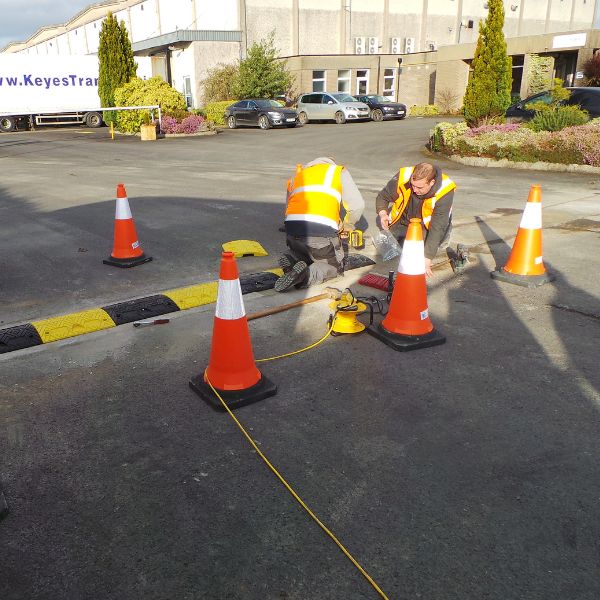Speed bumps play a crucial role in traffic management and safety, particularly in areas requiring vehicles to slow down for the safety of pedestrians and other road users. Ensuring these traffic calming devices are correctly installed and maintained is vital for their effectiveness and longevity.
The Use of Speed Bumps in 2024
Speed bump use is still growing in 2024 and continues to contribute significantly to road safety by forcing drivers to reduce their speed in high-risk areas. While other methods have been trialled in particular areas, speed humps still tend to be the traffic calming device of choice due to their effectiveness at slowing all manner of vehicles. Their effectiveness, however, is heavily reliant on proper installation and regular maintenance.
Selecting the Right Speed Bump
Before installation, selecting the right type of speed bump for your location is crucial. Consider factors such as the expected volume of traffic, the types of vehicles predominantly using the road, and the desired speed reduction. For instance, speed bumps are better suited to areas where there is a greater need to reduce traffic speed immediately, while speed cushions or speed tables are ideal for reducing traffic to a reasonable speed in order to maintain traffic flow, such as towns and cities.
In the UK, compliance with local guidelines and standards is essential to ensure that the speed bumps will be both effective and legally compliant.

UK Speed Bump Regulations
As part of the Highways (Road Humps) Regulations 1999 there are a number of factors to consider before installing speed humps.
- Speed bumps should not be installed within 30 metres of a pedestrian crossing
- Roads with a speed limit of 20mph or higher must have speed bumps installed at a right angle to the centre of the road
- They cannot be installed at a level crossing or within 20 metres of a level crossing
- They cannot be installed within 25 metres of a motorway structure
- Speed humps must be a minimum of 25mm high and a no more than 100mm high
- They must be well-lit by at least 3 lamps within 38 metres of the speed bump or by lighting designated specifially for the speed bump
- Appropriate signage should be installed to alert drivers

Speed Bump Installation Best Practices
-
Preparation: Before installing speed bumps, thoroughly assess the area. Ensure that the chosen location does not impede emergency services and is visible to drivers. Ensure that the chosen speed bump design best suits the need of the area. If more than one speed bump is required for an industrial setting ensure that they are distanced at least a vehicles distance apart. Proper signage should also be placed before the speed bump to alert drivers.
-
Materials and Specifications: Use high-quality, durable materials suited to the UK's varied weather conditions. Modular rubber traffic calming designs are ideal for British roads as they are much more durable and cost-effective compared to concrete humps. Specifications such as height, width, and spacing should follow the regulations as set out above to ensure they are effective for all vehicle types.
-
Visibility: Speed bumps should be highly visible so that drivers can easily see them on approach and so that they are visible in all weather conditions. Reflective markings can also enhance visibility during night-time or low-light conditions. In car parks or private premises traffic bollards can be installed alongside the speed bumps to give a better indication to drivers that traffic calming measures are in place.
-
Installation Process: The installation should be carried out by professionals with experience in traffic and safety equipment. Correct installation to the road surface is essential to prevent shifting over time and to ensure the speed bump remains effective and safe for all vehicles. The area should be cleaned of debris as much as possible and all speed bumps should be installed onto a level surface. Installation over holes or uneven ground can result in extremely fast degredation and need for replacement. Gaps on either end of long speed bump sections is also ideal for allowing drainage of water or snow - they do not need to be installed exactly from kerb to kerb. Consult the local authority

Speed Bump Maintenance
-
Regular Inspections: Conduct regular inspections to identify wear and tear or damage. This is particularly important after extreme weather conditions, which can accelerate deterioration. Look for worn sections that need to be replaced, reflective markings that need to be cleaned etc.
-
Prompt Repairs: Any damage identified during inspections should be repaired promptly to maintain the effectiveness and safety of the speed bump. Delayed repairs can lead to further damage and potentially hazardous conditions. Modular traffic calming devices allow for faster replacement and repairs.
-
Cleaning: Regular cleaning is necessary to maintain visibility and effectiveness. A build-up of dirt and debris can make speed bumps less visible and potentially slippery, reducing their safety benefits.
-
Documentation: Keep detailed records of all maintenance, repairs or replacements. This documentation can help in planning future maintenance schedules and provide evidence of compliance with safety standards.
Considerations
In the UK, it's essential to ensure that speed bumps comply with local regulations and standards. This includes adhering to the Traffic Calming Regulations 1999, which specify the dimensions and placement of speed bumps. Additionally, considering the impact on emergency vehicles is crucial, and consultation with local authorities can provide guidance on acceptable designs that minimise response times while still effectively reducing speed.






